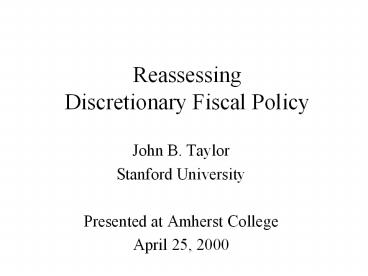Reassessing Discretionary Fiscal Policy - PowerPoint PPT Presentation
Title:
Reassessing Discretionary Fiscal Policy
Description:
Last attempts at discretionary fiscal policy. 1992 Bush Stimulus package: rejected. 1993 Clinton Stimulus package: rejected. Reason for rejection: budget deficit ... – PowerPoint PPT presentation
Number of Views:31
Avg rating:3.0/5.0
Title: Reassessing Discretionary Fiscal Policy
1
Reassessing Discretionary Fiscal Policy
- John B. Taylor
- Stanford University
- Presented at Amherst College
- April 25, 2000
2
Fiscal Policy Gun Is Reloaded
- Last attempts at discretionary fiscal policy
- 1992 Bush Stimulus package rejected
- 1993 Clinton Stimulus package rejected
- Reason for rejection budget deficit
- Now deficits are gone, so counter-cyclical policy
is ready to be used again - But should we use it?
3
Why a reassessment?
- Changes in monetary policy
- More emphasis on inflation control and keeping
aggregate demand close to aggregate supply - More reactive to both inflation and real GDP
- Favorable effects on both
- Changes in macroeconomic policy evaluation
research - New normative macroeconomics
- Example. Monetary Policy Rules, U. Chicago Press,
1999
4
A Simple Framework For Analyzing Countercyclical
Policy
- y ? ar u
- r b? v
- ?-1 cy-1 w
- r real interest rate
- y real GDP
- (measured relative to potential GDP)
- the inflation rate
- u,v, and w are shift terms
5
6
Three cases relating to countercyclical monetary
policy
- (1) Goldilocks economy--ideal, no change
- (2) Too cold--cut interest rates
- (3) Too hot--raise interest rates
7
Too hot example from Feds Monetary Policy
Report, Feb. 2000.
- aggregate demand may well continue to outpace
gains in potential output over the near term, an
imbalance that contains the seeds of rising
inflationary and financial pressures that could
undermine the expansion. ... The level of
interest rates needed to align demand with
potential supply may have increased
substantially
8
Compare discretionary fiscal policy
- Cyclical goals same as monetary policy
- keep AD potential when inflation is on target
- Also shifts AD curve, but
- Lags longer (implementation)
- Harder to reverse
- Could make Feds job harder
- And Fed reacting more than before
9
Zero Bound on Interest Rate
- Example of Japan
- Causes non-linearity in policy rule
- r b? (with b gt 0) for i gt 0
- r i - ? - ? for i lt 0
- Possibility of downward spiral
- Kinked aggregate demand curve
- Role for fiscal policy enhanced
10
Nominal interest rate
Constant Real Interest Rate
Policy Rule
Inflation rate
0
Target
11
Figure 2. The Kinked
Aggregate Demand Curve. The upward sloping
unstable region starts when the zero lower bound
on the interest rate is reached.
Real GDP
12
Other arguments
- Monetary policy constrained by fixed exchange
rates - Credibility problems prevent central bank from
reacting to y
13
Fiscal and monetary rule together
- r h? gy r
- s fy s
- where
- s is the budget surplus as a share of GDP
- s is the structural surplus
- s - s is the cyclical surplus.
14
(No Transcript)
15
(No Transcript)
16
Conclusion
- Fiscal policy should focus on the automatic
stabilizers - Could even become less responsive, as appears to
have happened already - Save discretionary actions for longer-term
issues and for unusual situations when monetary
policy might have relatively little power. - Monetary policy has done a good job at keeping
aggregate demand close to potential GDP. - Seems hard to improve on this performance with a
more active discretionary fiscal policy, and such
a policy might even make this job more difficult.
17
END































